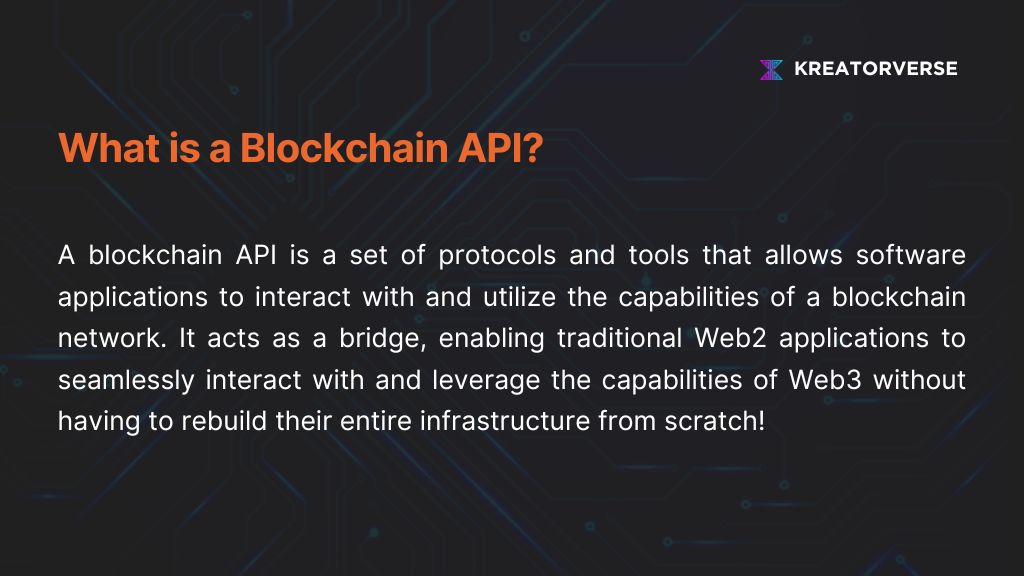Innovation is the hallmark of any financial service and institution, including banks. The obvious next step in financial innovation is to embrace decentralization. However, this is easier said than done. Banks face challenges in foraying into Web3 – technological blocks, cost of training and implementation, and lack of expertise. Blockchain APIs are game-changers in these aspects, bridging the gap between where banks are and where they want to be.
The world of finance is going through a revolution that’s shaking the foundations of traditional banking. The rise of Web3 and blockchain technology has rewritten the game’s rules. Financial institutions (FIs) are at a crossroads: embrace this seismic shift or risk being left behind.
Not convinced? Here’s some data to help you realize the scale of the revolution –
- The global blockchain market is estimated to grow from $1.4 billion in 2022 to $43.1 billion by 2030.
- By the end of 2030, blockchain will empower banks to save up to $27 billion in cross-border settlement transactions, reducing costs by more than 11%.
- More than 90% of major North American and European banks have started exploring blockchain technologies.
These figures underscore blockchain’s monumental growth trajectory and highlight the imperative for FIs to integrate these technologies into their operations.
But here’s the catch—the transition from Web2 to Web3 is not easy. Like any other innovation, it has its challenges.
From a lack of in-house expertise to the complexity of Web3 development projects, FIs may face obstacles that slow their progress and drain their resources. Navigating a maze blindfolded can be like navigating a maze, with every wrong turn leading to another dead end.
Amidst this chaos, Blockchain APIs have emerged as a game-changer for financial institutions in every possible way. These powerful tools offer a solution to help Web2 digital banks and FIs integrate with Web3 protocols easily, bridging the gap between traditional finance and decentralized finance (DeFi).
The Roadblocks on the Path to Web3 Adoption
Before delving into the transformative potential of APIs, let’s take a closer look at the roadblocks they’re facing on their journey to Web3 adoption:
Lack of Internal Expertise
Web3 and blockchain technologies are still relatively new. Most FIs, therefore, lack the in-house expertise to navigate this complex landscape effectively. A massive knowledge gap must be bridged, from understanding decentralized protocols and smart contracts to managing tokenized assets and decentralized finance (DeFi) applications.
Building this expertise in-house is challenging. FIs not only have to invest heavily in training programs for their existing workforce but also engage in a fierce battle for top talent with specialized skills in blockchain development, cryptography, and Web3 architecture. It’s like trying to assemble a dream team of superheroes, each with unique powers, in a world where such abilities are in short supply.
Complexity of Web3 Development Projects
Building Web3 applications and integrating with existing Web2 systems is like trying to merge two different worlds. It requires a deep understanding of blockchain architectures, consensus mechanisms, and the intricacies of various protocols, such as Ethereum and Polkadot. And that’s just the tip of the iceberg. Managing the interoperability between centralized and decentralized systems introduces a new set of technical challenges.
Imagine building a bridge between cities with vastly different infrastructures, cultures, and languages. FIs face the same challenge as they strive to facilitate smooth communication and data exchange between their legacy systems and the decentralized applications while addressing issues like scalability, transaction throughput, and latency.
Security Challenges
Blockchain technology and Web3 applications introduce a new set of security considerations that traditional FIs may not be equipped to handle. Unlike centralized systems, where security measures can be implemented and controlled from a central point, decentralized systems rely on distributed trust and consensus mechanisms, requiring a fundamentally different approach to security.
Ensuring the safety of digital assets, such as cryptocurrencies and non-fungible tokens (NFTs), is a critical concern. FIs must implement robust security measures, like secure key management, multi-signature wallets, and advanced encryption techniques, to protect these assets from threats like hacking, theft, or loss.
It’s like building a fortress to safeguard your most valuable treasures in a world where defense rules constantly evolve. And let’s not forget smart contracts—these self-executing contracts on the blockchain can be vulnerable to exploits and bugs if not developed and audited carefully. Any vulnerabilities in smart contracts can lead to significant financial losses and reputational damage for FIs, opening the door for cyber thieves to steal the loot.
Time and Cost Overburden
The learning curve associated with Web3 development is steep, and the trial-and-error approach often leads to significant delays and setbacks. It’s like trying to climb a mountain without proper training, a map, or a guide and trying to navigate the treacherous terrain while precious time ticks away.
FIs must factor in the time required for their teams to acquire the necessary skills, experiment with different protocols and tools, and iterate through multiple development cycles before achieving a production-ready solution.
This prolonged development timeline can result in missed opportunities and a competitive disadvantage in an industry where innovation and speed-to-market are crucial. It’s like being the last one at the party, only to find that everyone else has already gone home.
Let’s not forget about the financial burden, but one might wonder how bad it can be. Imagine building a skyscraper with limited funds and resources, constantly making trade-offs and compromises. It sounds disastrous. If the institution has limited domain expertise, Web3 development can be the same. The cost can escalate quickly, leaving you with three choices: spend more money, give up, or compromise.
Blockchain APIs: A Bridge to Web3 for Traditional Finance
Amidst these challenges, APIs (Application Programming Interfaces) are a source of hope. By leveraging these tools, FIs can build Web3 applications on top of blockchain protocols, seamlessly integrating decentralized technologies into their existing systems without requiring extensive in-house expertise or complex development efforts.

At their core, blockchain APIs leverage protocols like JSON-RPC (Remote Procedure Call) to communicate with blockchain nodes. This enables them to perform functions like querying account balances, retrieving transaction data, and even invoking smart contracts.
A key advantage of leveraging APIs is their ability to provide a standardized interface for interacting with diverse blockchain protocols. This abstraction layer shields developers from the nuances of each protocol. Their focus is then on building Web3 applications and integrations without delving into the low-level intricacies of blockchain architecture.
For instance, a financial institution that provides blockchain custody services could leverage a blockchain API. The API handles the complexities of securely managing digital assets across multiple blockchain networks, such as:
- Generating and managing wallets
- Signing transactions
- Ensuring compliance with industry standards and regulations
Moreover, blockchain APIs often incorporate pre-built components and libraries that streamline development. These components can significantly reduce the development effort required by financial institutions.
The Benefits of Embracing Blockchain APIs
Web2 banks and FIs can rapidly prototype and deploy Web3-enabled products and services by integrating APIs into their infrastructure.
Reduced Time to Market
Why spend months or even years developing Web3 capabilities from scratch? Financial institutions can significantly accelerate their time to market by integrating pre-built APIs. These APIs allow FIs to connect their existing Web2 infrastructure seamlessly with decentralized protocols and blockchain networks.
Blockchain APIs enable FIs to quickly prototype, test, and launch Web3-enabled products and services without requiring in-house blockchain expertise. This eliminates the time-intensive process of learning and mastering the intricacies of various blockchain architectures, including consensus mechanisms and smart contract development.
Minimized Development Costs
Building and maintaining Web3 applications from scratch is time-consuming and highly cost-intensive. This can become too much for a traditional financial institution with limited blockchain proficiency
Developing in-house expertise, hiring specialized talent, and allocating resources for experimentation and trial-and-error can quickly become a financial burden.
Partnering with an external expert who can provide custom APIs can be a cost-effective alternative. Web2 Banks can leverage a ready-to-use solution that is easily integrated into existing systems. With these APIs, FIs can bypass the need for extensive in-house development resources. Translation: significant reduction of overall costs associated with Web3 adoption.
Ensured Security and Compliance
Security and compliance are paramount for financial institutions, mainly when dealing with sensitive financial data and digital assets.
Therefore, crypto APIs are designed and developed with a strong focus on adhering to industry best practices and regulatory requirements.
They implement comprehensive security measures, such as advanced encryption, multi-factor authentication, and secure key management, to ensure the safety and integrity of transactions and data.
Additionally, work with an industry-leading vendor that closely monitors the evolving regulatory landscape and ensures its APIs comply with relevant laws and guidelines.
Access to Continuous Updates and Support
The Web3 ecosystem is constantly evolving. New protocols, features, and security enhancements are introduced rapidly within the blink of an eye. Keeping up with these changes can be daunting for financial institutions, especially those with limited blockchain expertise.
By partnering with a reputed external vendor, FIs can leverage experts who continuously monitor and update their APIs to support the latest advancements in the Web3 space. This ensures that the Web3 solution built for you remains future-proof and compatible with emerging technologies and standards.
Forging the Path to Web3 Innovation with Blockchain APIs
By embracing API-based infrastructure, traditional financial institutions can unlock Web3’s vast potential without being held back by its inherent complexities and resource constraints. This approach enables FIs to pivot towards decentralized finance (DeFi) offerings, tokenized asset management, and innovative Web3-native products and services while leveraging their existing Web2 infrastructure.
Kreatorverse helps FIs navigate the complexities of Web3 integration by optimizing their solutions for maximum performance and efficiency. By leveraging our blockchain APIs, digital banks and FIs can bridge the gap between Web2 and Web3 and tap into the vast potential of decentralized finance.
Book a call with us today to explore how Kreatorverse’s APIs can accelerate your Web3 transformation journey. Let’s build a product that seamlessly integrates CeFi with DeFi, unlocking a new market and growth opportunities for you.






